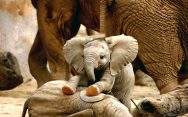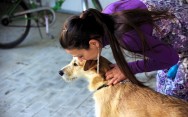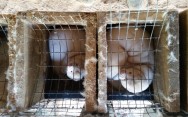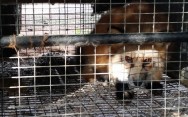Blog Archives
Home -
Archive by category "News" (Page 2)
Human ability to use language is the reason behind many spurious claims of human supremacy over animals. As science advances however, it’s become clear that animals, particularly social species like dolphins and apes, do use signals to communicate, from sign language to underwater acoustic signals.
The pattern recognition ability of AI is now being used to analyze large data-sets of animal communication behaviors. The aim is to find patterns in communication signals that correspond to animal responses. Soon, we may be able to communicate with animals and actually ask them what their perspective is rather than imposing our human-centered perspective on them.
The use of AI to divine the secret world of animal communication has a trans-humanist bent. It goes beyond our limited ideas about our place in the world and the cosmos, as uniquely gifted life-forms who have the right to do what we want to other species.
AI research doesn’t only cover individual animal communications (bioacoustics), but also ecosystem communication (ecoacoustics). Already this research is being employed in such projects as recording the development and health of a reforested area of rainforest. It is also being used to monitor marine communications from cetaceans (whales and dolphins) with highly developed acoustic languages as a way of identifying groups of animals that could be at risk of colliding with ships and to establish marine protection zones.
Since animals are autonomous, sentient beings with their own agenda, it’s not clear if they will welcome communication initiated by humans. Whenever paradigm-changing technology arrives, it should always be wielded with extreme care to manage its impact on all forms of life and ecosystems. In the best case scenario, when humans decentralize our place in the natural world with a new understanding of animal communication, we could start to see human choices as a process of consultation with the animal and natural world rather than a cruel process of dominion over it.
https://www.weforum.org/agenda/2023/01/how-artificial-intelligence-is-getting-us-closer-to-talking-to-animals/
Vietnam’s illegal wildlife trade is notorious for the sale of dog meat and the cruel treatment of animals caged and sold at so-called “wet-markets.” The country has committed to ending some of these cruel practices, but a probe has found that the cruel animal trade still persists.
The scenes of suffering that play out for animals are diverse and tragic.
Consider the following:
A water-bird is tethered to the top of a small cage with 6 others of its species. This agonizing prison is where these birds will spend their last moments, in noisy markets known as “wet markets.” At these markets animals are slaughtered in front of each other. Many of the animals brought to the markets are rare birds and endangered animals like turtles.
Or imagine what it’s like for a dog who is kidnapped from their owner or off the street, and bundled into a tight cage with other dogs who are frightened, confused, hungry and/or sick. As a captured dog, you witness other dogs being slaughtered in front of you until it’s your turn to be killed. These are the scenes that still play out in Vietnam’s dog meat trade. 88% of people want to end the dog meat trade, but there are no nationwide laws in Vietnam to prevent it.
Wet markets have become notorious since the COVID outbreak due to the health consequences of animal to human disease transmission. At wet markets, animals are kept in miserable conditions and routinely killed without even being stunned.
Vietnam’s prime minister has issued a directive that calls on regional authorities to crack down on wet markets and enforce existing laws to curb the trade of endangered animals. The government has made efforts to curb the dog meat trade in big cities but these efforts are still piecemeal. The investigation by We Animals Asia and the Asia Animals Coalition showed that post-COVID, people have gone back to business as usual, abducting dogs and animals from the wild and enthusiastically slaughtering and selling them at bustling wet markets and restaurants that serve dog meat.
To help animals who are killed and treated cruelly in Asia the public must continue to send the message that these practices are heinous and unacceptable. Work must be done to assist any initiatives that support enforcement and the rescue of animals. To learn more about how to support these efforts, please visit Animals Asia and the Asia Animals Coalition.
|
Tags: Animal Activism,
Animal Cruelty,
Animal Rescue,
animal rights,
Animals Asia,
Dog-Meat Trade,
Endangered Animals,
Endangered Birds,
Kevin Boileau,
Nazarita Goldhammer,
Transhumanism
Giving animals, trees and rivers legal rights is no longer a fringe idea. The Law Society, the professional body for solicitors in England and Wales, has produced a report that says that granting legal rights and protections to non-human entities such as animals, trees and rivers is critical if nations are to confront climate collapse and the collapse of habitat and biodiversity.
The report is called Law in the Emerging Bio Age. The title indicates the big shift in thinking when it comes to humanity’s view of our place in our environment alongside other creatures. The idea that we live in the “bio age” is correct. Humans can no longer rely on the conceptual framework of the Western Christian tradition, in which we are outside nature and have dominion over nature. This attitude has brought us to the brink of the extinction of our species. It has destroyed whole species in the great age of extinction caused by pollution and human activity.
It’s time to move beyond the destructive power of exploitative traditions that inform our law and our societies. We can look to societies and nations that are informed by indigenous traditions for inspiration. Ecuador for example, has enshrined legal rights for the natural world, based on the tradition of respecting the earth mother goddess, Pachamama. Bolivia has also granted rights to nature. New Zealand has granted personhood to a former National Park, Te Urewara Park, the Whanganui river and Mt Taranaki.
In the West, in certain countries and states, the law has started to consider that animals should be defined as people rather than property in divorce cases.
These changes represent promising new seeds, but more has to be done to protect the vast swathes of the earth and its creatures that are vulnerable to human exploitation. It is time to accept that we live in the “bio age,” and time to build a new legal and political framework to legislate for our connectedness to natural and animal life.
Read More:
https://vjel.vermontlaw.edu/rights-nature-movement-closer-look-new-zealand#:~:text=Rather%20than%20incorporate%20a%20rights,Taranaki.
https://www.theguardian.com/environment/2022/oct/10/give-legal-rights-to-animals-trees-and-rivers-say-experts
“Please forgive me. If I don’t kill you, I can’t feed my family” was the desperate apology a slaughterhouse worker used to whisper to the dogs in their cages in the Cambodian slaughterhouse where he used to work. The worker burst into tears as he described killing up to 6 dogs a day in a Cambodian slaughterhouse. Unlike workers in slick Western meat processing plants who are removed from the killing, Cambodian workers who participate in horrific violence on a daily basis fully experience the reality of what they are doing.
The dogs themselves are rounded up and put into cages and then suffer a drawn-out, tortuous end to their lives. They are transported to the slaughterhouses in crowded cages huddled with other dogs, and kept in rusty cages before being killed. The dogs are killed in brutal, horrific ways with no agreed upon system of killing. Some are hung from trees, others are drowned in fetid water. Some are strangled. Some are stabbed and some are beat over the head. Workers learn to prefer beating dogs over the head because it’s quicker, or drowning them in closed cages so they don’t have to hear their cries.
Yet amid all the horror, somehow there is a ray of light for Cambodian dogs. The organization Four Paws, which has worked tirelessly on behalf of dogs in Cambodia, has succeeded in shutting down the worker’s former employer, one the country’s biggest slaughterhouses. If the closure of this business disrupts the supply chain, it will send a strong message about the acceptability of the dog meat trade in Cambodia. The province of Siem Reap has also decided to ban the trade. But in Cambodia over 3 million dogs a year are slaughtered for the dog meat trade. There is still so much more work to be done to turn the tide against this horrific slaughter.
Four Paws did not just shut down the slaughterhouse, it supported workers to find alternative income and helped some of them to open a grocery store. The organization follows through on an understanding of the relationship between human misery and animal misery. One begets the other as poor workers are forced to kill for a living and dogs die to make profits for rich humans who are conveniently removed from the killing. The kind of clothes that those in business wear are different from the blood-stained rags of hired animal killers, yet it is the clean suits that are the real hallmarks of mass killers.
In a poignant moment, the worker who had murdered the dogs was able to release fifteen of them from their cages when the factory shut down. This time the worker was able to whisper to the animals: “you are free now” In this moment, the workers’ freedom and the animals’ freedom were not different, they were intricately intertwined and impossible without each other.
Please visit Four Paws website and make a donation to support the important work they are doing: four-paws.us/campaigns-topics/campaigns?utm_source=google&utm_medium=grant&utm_campaign=Evergreen&utm_content=UNR1907ADGRNTevergreenBrand&gclid=EAIaIQobChMInt2_1rKq6wIVFIzICh25fAV7EAAYASAAEgLww_D_BwE
https://www.scmp.com/news/asia/southeast-asia/article/3037201/inside-cambodias-brutal-dog-meat-trade-which-claims
When Whip’s owners’ went to feed their beloved horse in the morning, they found he was gone. Then they wandered into a nearby field where they made a horrific discovery. They found the body of their beloved friend and family member, completely butchered. This was a cold blooded killing: the horse had been butchered in the dead of night, somewhere between midnight and 5am, ostensibly for his meat. There have been other similar incidents in nearby counties, indicating that a killer may well be targeting horses in the local area.
The Sheriff’s Office and the Florida Agricultural Crimes Intelligence Unit are working on this crime and Collier County deputies have increased their presence in areas where people keep horses. Just like serial killers who target humans, it seems vulnerable horses are being preyed upon. Horses can be picked off by killers at their leisure as they graze in fields, powerless to protect themselves.
It is difficult to imagine what Whip went through in his final minutes or hours. The killer worked in the dead of night to butcher Whip, and more than likely took pleasure in the horse’s suffering. Whip’s owners describe themselves as grief-stricken. Their loss is the loss of a family member. They explain how they miss the 8 year old horse Whip, who they adopted as a four year old, and his “great personality.” Their loss is the loss of a sovereign individual who can never be replaced, and worse, a family member who was killed in the most brutal and gruesome way. Whip’s family are offering a $12,600 reward to anyone who can provide info about the person who killed him. This cannot bring back Whip, but if his killer is caught, another horse will not have to endure the unimaginable pain of brutal violence, and another family will not have to grieve the loss of beloved family member.
https://www.nbcnews.com/news/animal-news/family-s-horse-found-butchered-florida-horrific-crime-n1145841
There are times when a death toll goes so high that the significance of numbers is nothing but the complete loss of their significance. No longer are numbers able to speak of the loss of the individual to a community, to a family, to a habitat. The only thing they are able to speak of is the loss of meaning, the incalculable damage done to life itself. When we hear of a human death toll – a disaster, a massacre — the number of dead hits us like a blow to our sense of individual destiny: the right we think we have to thrive, to matter. The dead are like a wave that sweeps across our consciousness, constantly overwhelming our efforts at recognition, at the distinction we humans find between ourselves and others, our environment. We are connected with others in our helpless masses, no longer as helpers or community members, but as mere victims. The numbers stand while we fall, unable to resist the magnitude, the amplitude of the loss.
The numbers of estimated animal dead in Australia cannot be compared to a human village, nor a town, nor even a nation. Instead, the numbers of estimated animal dead in Australia’s fires make up one eighth of the world’s human population today. This animal death toll doesn’t even include frogs and insects.
As humans, we work among the ruins of our own disasters to regain our personal significance. We cling on to activity: gestures of solidarity, statements about change that are as much made to feed the ego as to stake out a real commitment. We reassure ourselves that we are individuals, that we matter. In the wake of Australia’s fires, humans feeding baby koalas and wrapping them in blankets are broadcast as a signal of activity that fills the void of disaster. They speak of our ability to care, to matter, as helpers and agents for animals. Despite the great good of these activities, they do not speak of the loss and grief of animals themselves, nor of their situation as displaced individuals and families who have been devastated by Australia’s inadequate climate change policy.
The animals who have survived have lost their family members and in some cases their entire habitats or livelihoods. The best known example is the Koala, which has been decimated by the fires on Kangaroo island. These koalas had represented a sanctuary and a reserve, protected from the chlamydia that has kept other koalas from reproducing successfully. There are questions over whether a small marsupial which lives its life shielded from danger in greenery has any real shot of sustainable existence in its hollowed out home on Kangaroo island.
We humans imagine death from fire as striking these animals with explosive might, but before the fires, animals were already dying of exposure to intense heat. Birds were dropping out of trees. Animals were starving because their food supplies were drying to a crisp. The fires that have grabbed human attention have left animals homeless. Those who have survived and haven’t received medical attention are enduring great suffering from hunger and injury. The Australia fires have unearthed a world of animals who carry on their lives whether we notice or care or not.
We need to follow the story of animal lives beyond this crisis as they now evade opportunistic predators like feral cats, as livestock dead create bio-hazards for animals, as they move about and use their ingenuity to survive but often fail to make it. Animals, like humans, do what they can to survive, including sheltering together in wallaby burrows. Heroic working dogs have rescued animals from fires. The sight of injured animals, baby koalas clutching stuffed animals, should remind us that other species have their own emotional needs and communities. Everyday animal lives, not human heroism, are the ignored clues to helping animals and working alongside them. For example, it should have been clear by damage from the heat wave in Australia, and by animal behavior, that climate change disaster was already preying upon the animal population. The fear is that California “will be next.” The sovereignty of animal lives needs to be consistently observed and recognized outside of disaster scenarios. Waking up to animal sovereignty, animal pain, animal solidarity can transform the death of animals from a number into an accountability for the loss.
The rescue efforts are not going to stop when the fires start to disappear from the headlines. This article has some information on how to support the rescue efforts going on: https://www.cnet.com/how-to/australia-fires-have-killed-more-than-a-billion-animals-so-far-how-you-can-help/ However, ongoing donations to animal conservation organizations such as the World Wildlife Federation are needed indefinitely. Commitments to fight climate change and move away from animal exploitation and death are needed Right Now.
https://www.latimes.com/environment/story/2020-01-14/australia-fires-killed-millions-of-animals-kangaroo-island
https://www.cnet.com/how-to/australia-fires-have-killed-more-than-a-billion-animals-so-far-how-you-can-help/
https://www.nbcnews.com/science/environment/more-1-billion-animals-killed-australian-wildfires-n1112326
Australia’s Capital Territory has just taken an important leap forward in the legal treatment of animals. The new laws in Australia’s Capital Territory recognize that animals can perceive and feel the world around them and have “intrinsic value.” These concepts finally depart from the legal structures which incarcerate animals as objects designed for humans’ use and abuse, and which characterize most legal systems around the world.
The laws impose sizeable fines and prison sentences for confining animals, lack of animal care and participating in cruelty to animals. They also move to restrict pet shops and the pet shop industry.
There is reason to celebrate the passing of these laws, but a good beginning mustn’t be a permanent band-aid. This article is right to point out that “animal sentience” does more to regulate treatment of pets than it does to change humans’ relationship with animals. Australian industries that harm animals won’t be expected to change. A “duty of care” is imposed on humans when they are in a relationship of care. But so many of human relations with animals are mediated through profit and product, rather than care. The new laws recognize that animals should not be humans’ property in the law. In practice they will defend the animals humans have chosen as pets, abandoning the animals victimized by industry. We can only hope that the interpretation of these laws and further activism will expand protection to animals who are still being brutalized.
Read More:
https://www.canberratimes.com.au/story/6407314/act-passes-australia-first-animal-sentience-laws/
In an ideal world, mourning the death of any living being should not bring relief for their passing. When death brings relief because a being has been suffering unimaginably however, we are glad the suffering has passed out of the world, at least. Often, the suffering of any animal comes in the form of pain or illness. In the case of Tikiri, the 70 year old elephant, her suffering was a result of years’ of slavery and abuse. The 70 year old Tikiri the elephant came to the world’s attention due to her emaciated appearance at a religious festival in Sri Lanka. The animal was used in a parade for 10 days each year. She was photographed in a skeletal, emaciated state, apparently malnourished and exhausted by her job. The elephant would march for days at this festival while hungry, exhausted and at an advanced age. Her body was covered with decorations to hide her terrible condition. Tikiri had been a working animal all her life, and was forced to march, despite being “India’s oldest elephant.”
It’s easy to forget that “fun elephant rides” for tourists are the other face of animal slavery. If tourists and those attending religious festivals boycott attractions and entertainments based on elephant slavery, unnecessary suffering could be prevented. That way, Tikiri’s suffering could at least lead to some kind of justice for others’ like her.
https://www.cnn.com/2019/09/25/asia/emaciated-elephant-death-sri-lanka-scli-intl/index.html
The couple who captured footage of closely packed together pigs did so on a casual detour. They had no idea they were exposing Canada’s animal outdated transportation conditions, they just noticed the animals were in discomfort and started filming.
In Canada, pigs can be trucked for up to 36 hours without a break for rest, food or water, compared to 8 hours in the European Union. These outdated laws are due for a change but no one has been paying attention.
Sometimes all it takes is a little push. The video is steadily gaining views. A recent Vancouver Sun story showed that 46 pigs had died being shipped from Alberta to Donald’s Fine Foods in Langley. Phone video footage is a small weapon which can have a huge impact, and thankfully it is easily accessible to most people. Please share the news and remember you can use your phone to pay attention to the conditions around you. You never know, it could save animal lives!
See the original article for details: https://www.kamloopsmatters.com/local-news/video-by-kamloops-animal-rights-group-prompts-investigation-984692








Social Media